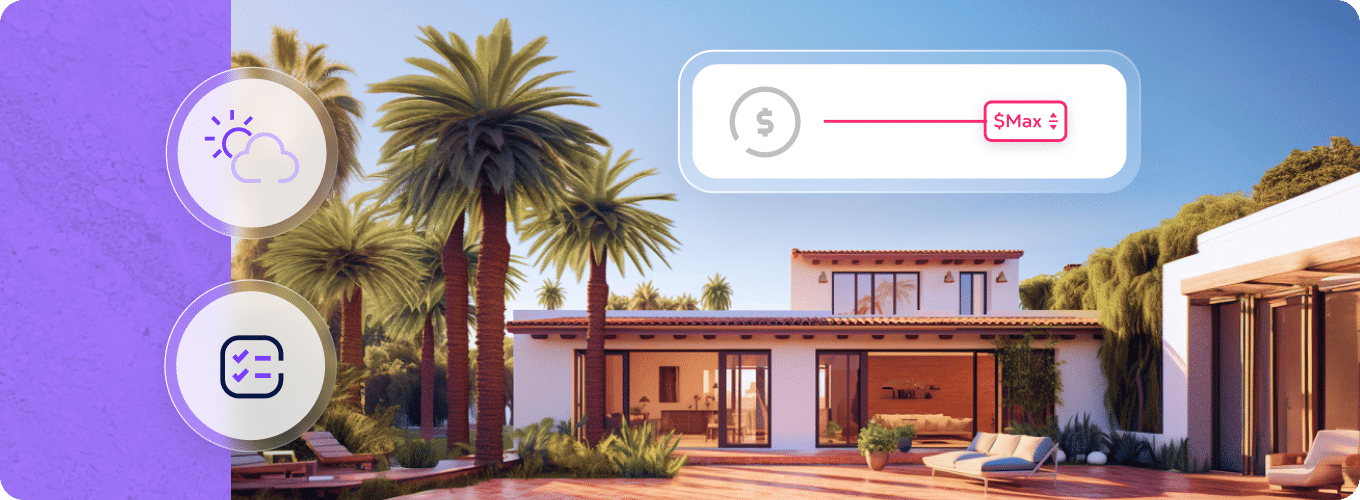As with any business, setting and adjusting rates for your vacation rentals can be a stressful challenge. Set your rate too high and you might suffer from a low occupancy rate, or your guests may have expectations that are higher than you can deliver. Set your price too low, and you may not realize the full potential of your property or even be able to earn a profit.
Properties that are priced the most accurately will get the most bookings. So, how do you make sure that you’re priced appropriately for your location and in a way that will make your short-term rental business profitable?
Whether you are just starting out or have been operating for years, follow our five-step plan to learn how to initially set your prices, and continue on to determine how you can re-evaluate and adjust your rates to maintain a competitive price range for your properties.

Setting Your Rates
1. Know your costs
External factors carry a lot of weight when it comes to setting rates for your vacation rental. But first, you need to focus on protecting the bottom line of each individual property: what is the minimum average daily rate (ADR) you can charge to break even?
Even once you’re up-and-running with regular bookings, it’s unlikely a property will be occupied every week of the year. Calculate all costs associated with the rental, then conservatively estimate how many weeks you feel you can book your space.
Guesty’s PriceOptimizer tool is a ready resource to help you gauge the accurate price rates in your market. By combing through multiple data points and crunching numbers into a pricing engine, you will be able to formulate a pricing strategy.
2. Know your competition
Once you’ve calculated your break-even ADR, you need to figure out how much you can actually charge by looking at typical rates for your area. If the market can’t support your minimum rate, you may need to reassess your plans.
To evaluate your competition, consider not just other vacation rentals – which you can track through listing sites like HomeAway, Vrbo and Airbnb – but other accommodations in general.
Vacation rentals have a few distinct advantages: They generally provide more space, more comfort, and are more affordable for longer stays. However, there are always other options for travelers looking for a place to stay.
Other Vacation Rentals. When researching other vacation rentals, focus on those that are comparable to your property. For example, if you have a two-bedroom beachfront condo, focus your research on other two-bedroom beachfront condos.
Depending on the size of your market, you may be able to narrow your research even further according to amenities and other prominent features.
Bed & Breakfasts. B&Bs are a niche market where guests are more catered to than short-term renters.
While you should be aware of B&B rates in your area, their relevance also depends significantly on the market you’re chasing. Only eight percent of guests stay at a B&B for three days or longer, so if you’re targeting two or three day rentals, the comparison will matter quite a bit. If your focus is weekly rentals, B&Bs will be less of a factor.
Hotels. Writer Anne Frugé suggests this calculation when considering local hotels. “If your vacation home sleeps a family of 6, how many hotel rooms would they need?” she tells Ezine. “If it’s 2, multiply the hotel’s nightly rate by 2. If your nightly rate is higher, perhaps your amenities make it worth the difference.”
Depending on the market and your own preferences, you may focus on weekly rentals or offer a nightly rate. A standard calculation is to set your nightly rate to one-fifth or one-sixth of your weekly rate.
You may also want to consider a monthly rental rate, which follows a slightly different formula. Research from HomeAway suggests setting long-term reservations – especially during shoulder or off-season periods – at a lower rate.
“In the shoulder or slower season, when you might only rent two to three weeks each month, charge the same for the month that you would for two full shoulder season weeks. And for low season months – that may or may not rent at all – price the month the same as approximately two weeks of your off-season rate.”

3. Setting your highs and lows
As you collect information about your competition, take note of the following details:
- What do they note as high and low periods?
- What are their rates during these different seasons?
- When do they typically offer package deals, and how do those deals impact their rates?
Pay close attention to your local market conditions as well. The ‘peaks and valleys’ in the local market may or may not significantly influence you, but you can certainly use it as a guide.
The schedule for the school year (which can differ from one region to the next) can impact active and slow periods, as can your local events calendar and other regional influences (i.e. ski season, hunting, fishing, the beach, etc.).
In some areas, local regulations also set requirements around short-term rentals, so make sure you’re up to speed on any bylaws that may impact your planning.
A final element to consider is whether you want to set a minimum stay. Some vacation rentals always have a minimum stay requirement, while others set it during peak period only.
We recommend setting your minimum stay requirement to only one night if you are only listing on one or two channels so you can maximize your property’s audience by avoiding search filters. Alternatively, if you are on three or more channels, you can set a higher minimum stay because your exposure to a larger total audience across channels negates being filtered out of some travelers’ searches. In short, being on more channels will give you the privilege of taking better bookings.
4. Look at your property objectively
You’ve set a rate for high season and low, as well as related weekly and nightly rates. How do they compare to your competition?
If your rate is higher than that of your competitors, do the amenities and space you offer justify the difference? If it’s lower than your competitors, are you underestimating the value of your property, or can you take action to close the gap?
Optimize and automate your rates with dynamic pricing
To simplify this process and to gain more competitive price points, consider automating the rate-setting process by using a dynamic pricing tool.
As mentioned earlier, the Guesty PriceOptimizer is a simple way to keep your pricing up-to-date with events, market changes, and seasons.
Guesty also integrates with and endorses two dynamic pricing software providers: Wheelhouse and PriceLabs. Each uses complex algorithms and competitive analysis to automate your properties’ rates and – when used with Guesty – these services will automatically adjust your listings’ rates in real-time and publish across your marketing channels. Keeping all revenue management in one place will make the numbers look simpler, and ensure pricing excellence.

Adjusting Your Rates
If you adjust your rates manually, it’s likely you’ll miss the mark and price too high or low at some point. If your rates are off, how can you adjust?
The first step is diagnosing the problem – if there is one.
Before you get too anxious about what you may or may not be doing right, do some research and consider:
- What rates and activity are typical in your area?
- What factors led you to set your high and low season rates in the first place?
- Would someone else objectively agree that your rate is reasonable?
- Could your marketing itself use a little tweaking?
Changing your rates one way or another as soon as you can may seem the straightforward solution — but wait! Take time to collect and assess feedback and information, then plan your next steps.
“I think my rates are too high”
If feedback you’ve received through inquiries has shaken your confidence, be careful you’re not taking bargain hunters too seriously.
FlipKey found that the average vacationer visits four vacation rental websites and inquiries on seven different properties; travelers like to shop, and they’re always looking for a better deal. Travelers find no harm in asking for a discount, so a request for a deal isn’t necessarily a sign that your pricing is off.
Most people are happy to pay less, so reducing your rates will increase your bookings. However, increasing rates if you find you’ve made a mistake could be troublesome as travelers are weary of volatility.
When you make a change, track the impact on both inquiries and bookings. If you’re happy with an increase in bookings, but still believe your property is worth the higher rate, survey guests when they leave. Do they feel they received good value? What did they particularly like? How can you improve?
Feedback will help you highlight what makes your property so valuable and unique, or identify adjustments that will help you meet higher expectations. Or you may find that the lower rate is your ideal price point after all.
“I think my rates are too low”
It’s easy to fall into a problem with low rates: people may underestimate the value of their property or the cost of running a vacation rental, or new costs that don’t fit the budget arise.
If you can’t break even for the year with your current rates, or you realize that you’ve undercut yourself, tread carefully.
If the difference between what you charge and your higher target rate is dramatic — or particularly minor — it may be best to do it and deal with it. When you raise your rates you may need to honor the lower price on occasion, like if someone has legitimately seen the lower rate advertised on a distribution channel.
Inaccurate rates are a common side-effect for property managers who use software with indirect integrations and third-party channel managers. To avoid these costly errors and ensure your rates are always accurate, employ property management software with direct connections to every major channel.
Otherwise, follow a similar procedure than above – step back and start by collecting information.
- Look at your competition: What are their rates at different times of the year and how do your properties compare?
- Solicit feedback from your guests: Do they feel they received value? Why did they choose your listing over others?
There are three groups of people to consider: new guests, guests who have already booked, and repeat renters. Anyone with existing bookings should be left as-is, but there are different ways for you to approach new and previous renters.
New Guests. It’s hard to “market test” increased rates; your rates are already published, and raising those rates too high — or quoting a higher price than has been promoted — could leave your home empty. However, you do have a few alternatives to increase your rates to where you feel they should be.
- Raise prices incrementally. Consider scheduling smaller increases over a year or two. Or you may find that you only need to adjust your high or low season rates.
- Offset higher rates, but with a seasonal discount as you transition. As you switch to higher rates, you could offer a seasonal discount so the actual price is only slightly higher. When the next season rolls around, remove the discount.
Repeat Guests. How do you adjust expectations for people who’ve stayed with you before? Consider these tips when handling your rate increase:
- Give people who have rented from you in the past lots of notice about the increase.
- Be specific about your new rates, and if relevant, share why your rates are increasing. Regular maintenance isn’t a good reason, but if the increase is needed because you’ve made some sort of property upgrade, let them know.
- Promote the value your property offers. For example, highlight some of the feedback you’ve received from happy guests.
- Outline any changes to the community. Maybe a new attraction is drawing more tourists to the area, making the market more active and competitive. Let people know about exciting new developments, it may encourage them to come back!
Much like determining your initial rates, adjusting your rates can be very tricky, and just when you think you have it right, it’s time to reevaluate. We encourage our customers to use dynamic pricing software like Beyond Pricing, Wheelhouse or PriceLabs, who – like Guesty – have proven track records in earning property managers more money.
Setting and adjusting your rates is complex and ever-changing, but committing yourself to a regular cadence of reevaluating your space and the surrounding competition will set you on the path to success.





